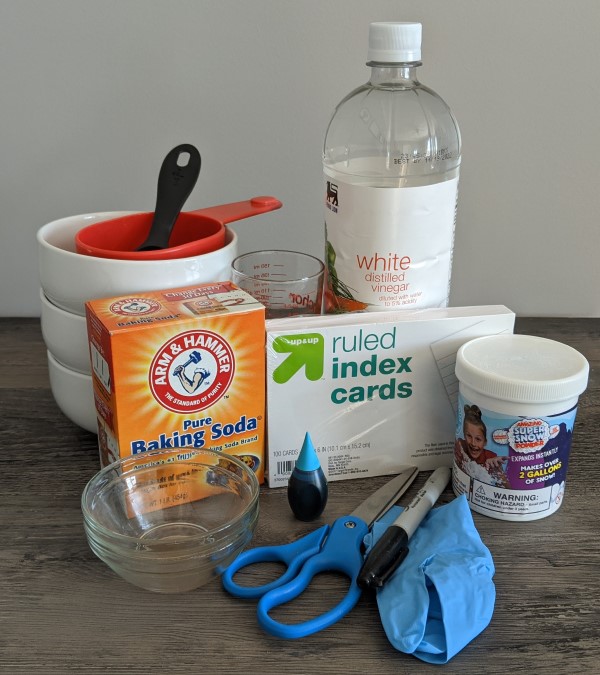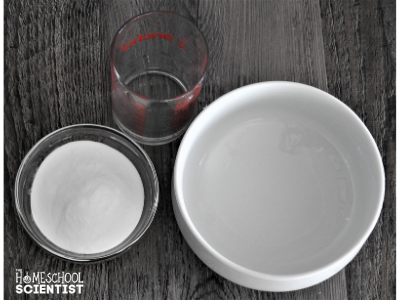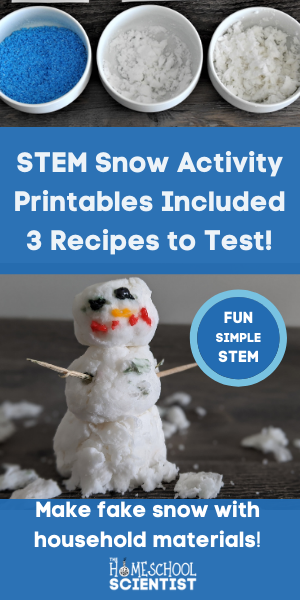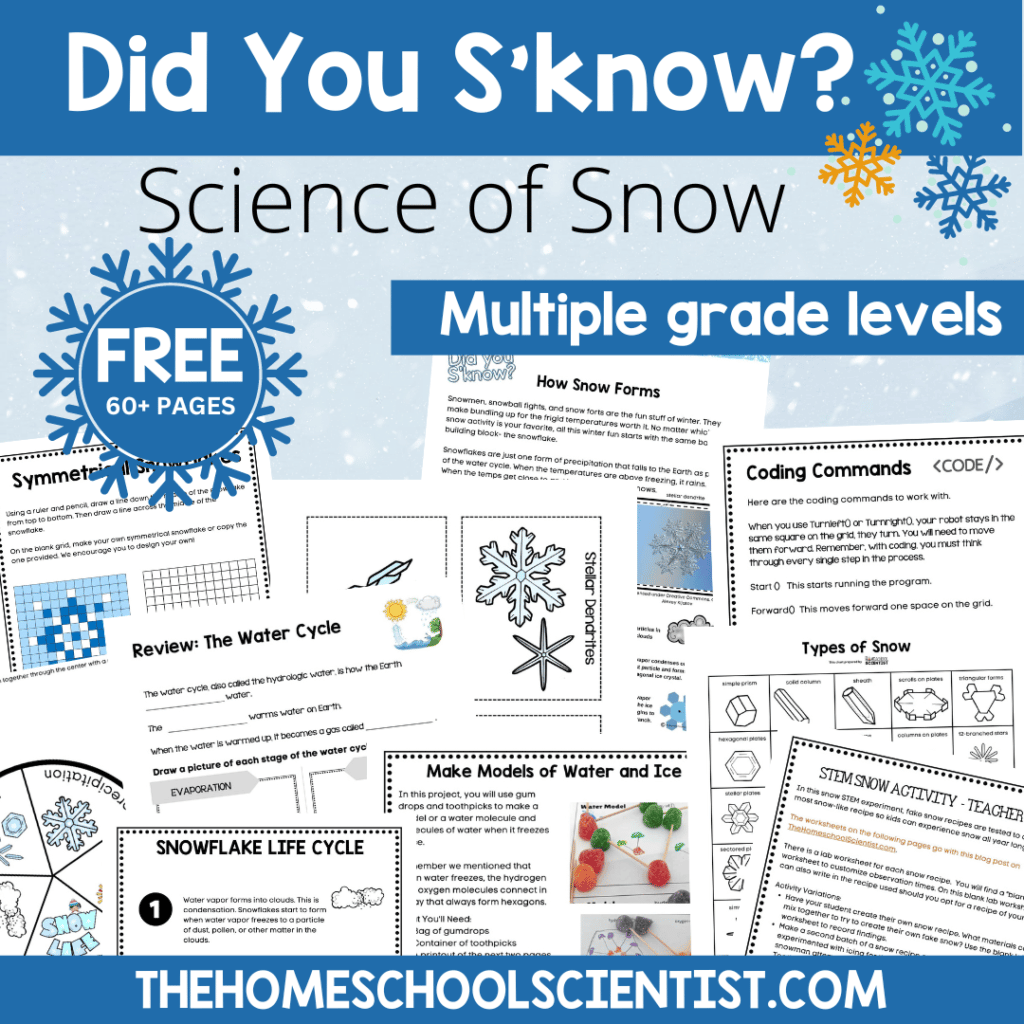Fun & Easy Snow STEM Experiment for Kids: Testing 3 Fake Snow Recipes
In this STEM experiment, fake snow recipes are tested to determine the most snow-like recipe so kids can experience snow all year long!
There is a lab worksheet we have created to go along with this snow STEM activity. See the email box just above the Recipe 1 section.
Snow is a magical substance that thrills most children from their heads to their toes. But not all kids have access to snow during the winter season. Children can still experience snow by making and playing with fake snow. But what fake snow recipe is the best?
Let’s experiment and find out!
Oh, and at the end of this post is a link to a STEM activity that uses fake snow. Check out the Build a Snow Plow activity.
Let’s Get Started with the Fake Snow Stem Activity
This post contains affiliate links.
Here’s a a video version of this activity.
Supplies You Need for this Fake Snow Stem Activity

- Baking soda
- White vinegar
- Paper towels
- Instant snow
- 3 bowls, one for each fake snow recipe
- Small containers to hold the baking soda and vinegar before they are used
- 1/2 cup measuring cup for dry ingredients
- Tablespoon or a beaker that has metric and tablespoon measurements.
- Blue food coloring (Optional for the Instant Snow. We found it’s easier to watch the physical reaction of the polymer and water when food coloring is added to the water prior to mixing it with the Instant Snow product.)
- Gloves (Optional. We wore them because of the skin irritation caused by vinegar.)
- Pencil or marker, scissors
- Index cards or paper to label the three containers of fake snow
The Science of Snow
Real snow is more than just frozen water. Snow forms when the atmosphere is at or below freezing (32 degrees Fahrenheit), but snow doesn’t always form every time it’s freezing outside. There must be a certain amount of moisture in the air to make snow. Most snowfalls when it is about 15 degrees Fahrenheit and warmer.
Snow crystals form when ice particles cling together combined with air. This makes a sort of “puffed ice” that turns into snowflakes. The more wind is in the air, the smaller the snowflakes will be as the air breaks apart the delicate structures. Snowflakes can be as large as 2 inches across, but usually are no larger than half an inch across.
Snow itself has unique characteristics. It is wet (although it can feel dry), makes a crunching sound when stepped on, and can usually be packed into a ball.
Take your snow STEM learning further with these snow-related blog posts:
Download the printable for this activity.
Fake Snow STEM Experiment
In this experiment, we tested 3 fake snow recipes. Use our lab worksheets to make a list of the properties of each type of snow as you conduct your experiments to determine which snow recipe is the most authentic. We have included a lab worksheet to go along with this snow STEM activity. See the email box below to receive the free worksheet. It’s ready to print and use!
Get the lab worksheets for this activity by signing up here. When the “Thank You” appears, the worksheets are on their way to you.
You will be subscribed to our email newsletter, which comes out at most twice a month. You may unsubscribe at any time.
Recipe 1: Instant Fake Snow
Instant fake snow is made up of synthetic polymers that are highly absorbent. These polymers are also found in disposable diapers.
Snow is formed by added water to the powder until the powder no longer expands. When fully expanded, the snow has a fluffy, snow-like appearance, but there is no crunch and it cannot be formed into snowballs.
What You Need for Fake Snow Recipe 1:
- 1 scoop of this polymer snow product “Super Snow.” The scoop is included in the container of Super Snow.
- 2 Tablespoons of water
- Optional: Add 2 to 3 drops of blue food coloring to the water before mixing it into the Super Snow.
Instructions for Fake Snow Recipe 1:

- Measure 2 tablespoons of water into a bowl. Optional: add 2-3 drops of blue food coloring and stir.
- Add the 1 scoop of Super Snow. Watch the physical reaction!
- After the fake snow expands, mix it around with your hand.
- Using index cards or paper, create a label for this bowl. Super Snow & Water
- How does it feel? Can you form the fake snow into a snowball?
- Fill out the lab worksheet for Recipe 1. Using the time intervals on the worksheet, record what happens to this mixture of fake snow. How is the mixture after an hour? 2 hours? 4 hours? 24 hours?
- Clean your area and prepare for Recipe 2.
Recipe 2: Baking Soda Fake Snow
This snow recipe is simply made of baking soda and water. Add just enough water to baking soda to form a snowball shape that crumbles when squeezed. This recipe has the most “crunch” factor similar to snow. It feels like wetter snow.
What You Need for Fake Snow Recipe 2:
- 4 Tablespoons of baking soda
- `1 Tablespoon cool tap water or room temperature water
Instructions for Fake Snow Recipe 2:

- Using the index cards or paper, create a label for this bowl. Baking Soda & Water
- Measure 4 tablespoons of baking soda into a bowl
- Add 1 tablespoon of cool tap water or room temperature water
- Mix well with your hands.
- How does it feel? Can you form the fake snow into a snowball? Can you make a snowman?
- Fill out the lab worksheet for Recipe 2. Using the time intervals on the worksheet, record what happens to this mixture of fake snow. Can you make a snowball over time? Can you make a snowman? How is the mixture doing after an hour? 2 hours? 4 hours? 24 hours?
- Clean your area and prepare for Recipe 3.
Recipe 3: Paper Fake Snow Using Vinegar, Baking Soda, and Paper Towel
Paper snow is made by mixing small pieces of paper towels with baking soda and some vinegar. This recipe has the most “crunch” factor similar to snow, but it’s rough texture prevents it from feeling as snow-like as some other recipes.
What You Need for Fake Snow Recipe 3:
- 1/2 cup of baking soda
- `3 Tablespoon white vinegar
- 1 paper towel cut into tiny pieces, which will yield 1 cup of paper towel pieces
Instructions for Fake Snow Recipe 3:

- Using index cards or paper, create a label for this bowl. Baking Soda, Vinegar, Paper Towel.
- Pour the paper bits into a bowl. (We cut the paper towel in half. Placed the halves together, cut the paper towel into very thin strips, then cut those strips into small pieces.
- Measure 1/2 cup of baking soda and add to the paper bits. Gently mix the baking soda and paper together. Be careful not to spill any of the baking soda.
- Measure 3 tablespoons of vinegar into a separate cup or bowl.
- Optional, put on the gloves if your skin is irritated by vinegar.
- Pour the vinegar slowly into the bowl or paper and baking soda.
- Mix well with your hands.
- How does it feel? Can you form the fake snow into a snowball? Can you make a snowman?
- Fill out the lab worksheet for Recipe 3. Using the time intervals on the worksheet, record what happens to this mixture of fake snow. Can you make a snowball over time? Can you make a snowman? How is the mixture doing after an hour? 2 hours? 4 hours? 24 hours?
- Clean your area.
If you haven’t requested the lab worksheets that go with this STEM snow activity, request them here. When the “Thank You” message appears (after you click Subscribe), your copy is on its way!
Fake Snow STEM Experiment Results

Using the lab worksheets we created, compare and contrast the characteristics of all the types of snow.
In our snow experiment, we felt that the baking soda and vinegar felt the most authentic. Experiment with other fake snow recipes to find your favorite!
Input your email address, and we’ll send the worksheets right to you.
You will be subscribed to our email newsletter, which comes out at most twice a month. You may unsubscribe at any time.
Download the FREE Did You S’know? Snow Science Printable
Use These Fake Snow Recipes When You Build a Snow Plow
Now that you have tried the fake snow recipes, test them out with a snow plow your kids or students design!
Check out this super-fun and creative STEM activity.
I hold a master’s degree in child development and early education and am working on a post-baccalaureate in biology. I spent 15 years working for a biotechnology company developing IT systems in DNA testing laboratories across the US. I taught K4 in a private school, homeschooled my children, and have taught on the mission field in southern Asia. For 4 years, I served on our state’s FIRST Lego League tournament Board and served as the Judging Director. I own thehomeschoolscientist and also write a regular science column for Homeschooling Today Magazine. You’ll also find my writings on the CTCMath blog. Through this site, I have authored over 50 math and science resources.






